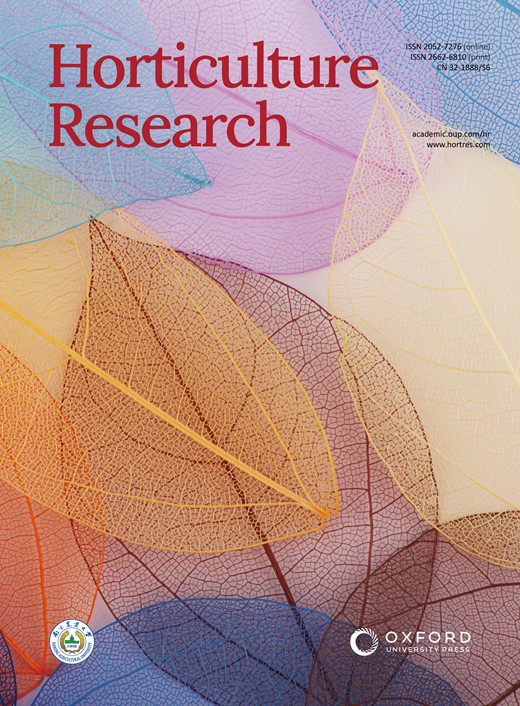表型1和PhPPT的共沉默通过减少磷酸烯醇丙酮酸供应来改变矮牵牛花花青素的产生
IF 8.5
1区 农林科学
Q1 Agricultural and Biological Sciences
引用次数: 0
摘要
莽草酸途径对芳香氨基酸和各种次生植物产品(包括花青素)的产生至关重要。磷酸烯醇丙酮酸(PEP)是生产莽草酸的重要原料。莽草酸途径的前choris酸部分仅限于质体。质体中PEP有三种来源。PEP可以通过PEP/phosphate translocator (PPT)从细胞质导入到质体中,也可以通过烯醇化酶(ENO)和丙酮酸正磷酸二激酶(PPDK)催化在质体中生成。大多数观赏植物的花在着色阶段都会合成大量的花青素。然而,花青素合成的前体PEP的来源仍然未知。本研究鉴定了矮牵牛(Petunia hybrida)表型1、PhPPT和PhPPDK基因,并分析了它们的亚细胞定位和表达模式。单独沉默PhENO1、PhPPT和PhPPDK,以及与PhPPDK或PhPPT与PhPPDK共沉默,与对照相比,没有明显的表型变化,而与PhPPT共沉默导致花的颜色由紫色变为浅紫色。表型1和PhPPT共沉默植株的PEP、莽草酸、黄酮类、花青素和芳香氨基酸含量均显著降低。共沉默表型1和PhPPT不影响花青素合成和莽草素通路关键基因的表达水平。此外,对表型1、PhPPT和PhPPDK的共沉默导致表型类似于对表型1和PhPPT的共沉默。综上所述,我们的研究表明,用于花青素合成的PEP主要由PhENO1和PhPPT提供,而不是PhPPDK。本文章由计算机程序翻译,如有差异,请以英文原文为准。
Co-silencing of PhENO1 and PhPPT alters anthocyanin production by reducing phosphoenolpyruvate supply in petunia flower
The shikimate pathway is crucial for the production of aromatic amino acids and various secondary plant products, including anthocyanins. Phosphoenolpyruvate (PEP) is an important source for shikimate production. The pre-chorismate part of the shikimate pathway is confined to plastids. There are three sources of PEP in plastids. PEP can be imported into the plastids from cytoplasm via the PEP/phosphate translocator (PPT), and it can also be generated in plastids via enolase (ENO) and pyruvate orthophosphate dikinase (PPDK) catalysis. A large number of anthocyanins are synthesized in the flowers of most ornamental plants in the coloring stage. However, the source of PEP, the precursor of anthocyanin synthesis, is still unknown. Herein, Petunia hybrida PhENO1, PhPPT and PhPPDK genes were identified and their subcellular localization and expression patterns were analyzed. Silencing PhENO1, PhPPT and PhPPDK alone and co-silencing of PhENO1 and PhPPDK or PhPPT and PhPPDK did not exhibit any visible phenotypic change compared with the control, while co-silencing of PhENO1 and PhPPT resulted in the flower color change from purple to light purple. The content of PEP, shikimate, flavonoids, anthocyanins and aromatic amino acids were all significantly decreased in PhENO1 and PhPPT co-silenced plants. Co-silencing PhENO1 and PhPPT did not affect the expression level of key genes in anthocyanin synthesis and shikimate pathways. Furthermore, co-silencing of PhENO1, PhPPT and PhPPDK resulted in a phenotype similar to the co-silencing of PhENO1 and PhPPT. Altogether, our study suggested that PEP used for anthocyanin synthesis is mainly provided by PhENO1 and PhPPT, rather than PhPPDK.
求助全文
通过发布文献求助,成功后即可免费获取论文全文。
去求助
来源期刊

Horticulture Research
Biochemistry, Genetics and Molecular Biology-Biochemistry
CiteScore
11.20
自引率
6.90%
发文量
367
审稿时长
20 weeks
期刊介绍:
Horticulture Research, an open access journal affiliated with Nanjing Agricultural University, has achieved the prestigious ranking of number one in the Horticulture category of the Journal Citation Reports ™ from Clarivate, 2022. As a leading publication in the field, the journal is dedicated to disseminating original research articles, comprehensive reviews, insightful perspectives, thought-provoking comments, and valuable correspondence articles and letters to the editor. Its scope encompasses all vital aspects of horticultural plants and disciplines, such as biotechnology, breeding, cellular and molecular biology, evolution, genetics, inter-species interactions, physiology, and the origination and domestication of crops.
 求助内容:
求助内容: 应助结果提醒方式:
应助结果提醒方式:


